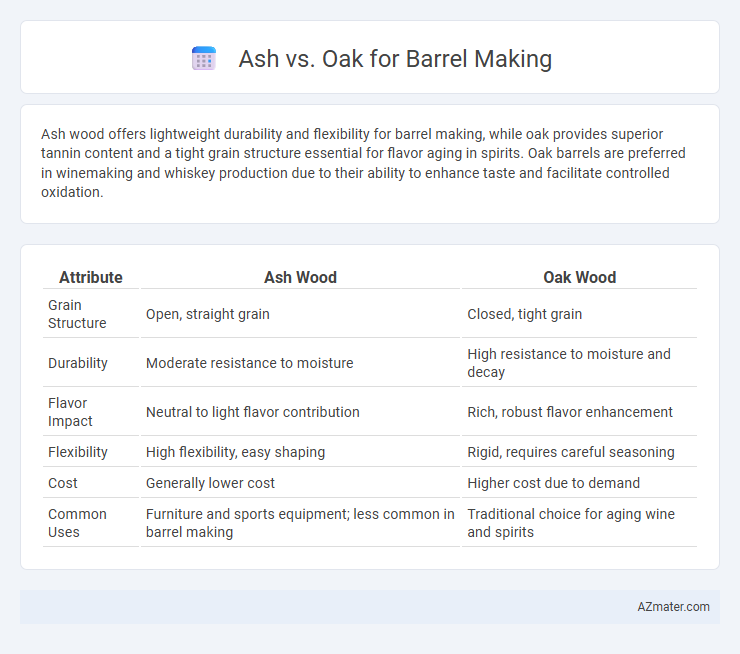Ash wood offers lightweight durability and flexibility for barrel making, while oak provides superior tannin content and a tight grain structure essential for flavor aging in spirits. Oak barrels are preferred in winemaking and whiskey production due to their ability to enhance taste and facilitate controlled oxidation.
Table of Comparison
| Attribute | Ash Wood | Oak Wood |
|---|---|---|
| Grain Structure | Open, straight grain | Closed, tight grain |
| Durability | Moderate resistance to moisture | High resistance to moisture and decay |
| Flavor Impact | Neutral to light flavor contribution | Rich, robust flavor enhancement |
| Flexibility | High flexibility, easy shaping | Rigid, requires careful seasoning |
| Cost | Generally lower cost | Higher cost due to demand |
| Common Uses | Furniture and sports equipment; less common in barrel making | Traditional choice for aging wine and spirits |
Introduction to Barrel Making Woods
Ash and oak are two prominent woods used in barrel making, each offering unique characteristics essential to cooperage. Oak, especially white oak, is prized for its tight grain, durability, and flavor-enhancing tannins that impart rich aromas and complexity to aging spirits. Ash provides a lighter alternative with a coarser grain, delivering distinct aromatic profiles and greater flexibility in barrel design, making it a valuable choice for innovative aging processes.
Unique Properties of Ash Wood
Ash wood offers exceptional strength and flexibility, making it ideal for barrel staves that require durability and slight elasticity under pressure. Its open grain structure allows for effective oxygen exchange during aging, contributing to nuanced flavor development in spirits. Unlike oak, ash imparts a lighter, subtly sweet character, appealing to distillers seeking a distinctive alternative for aging barrels.
Distinct Characteristics of Oak Wood
Oak wood is highly favored in barrel making due to its exceptional strength, tight grain, and high tannin content, which contribute to the aging and flavor profile of spirits and wines. Its porous structure allows for controlled oxygen exposure, enhancing the maturation process while imparting desirable vanilla, spice, and caramel notes. Unlike ash, oak's resistance to leakage and its ability to interact chemically with the liquid inside make it the superior choice for aging barrels.
Historical Use of Ash and Oak in Cooperage
Oak has been the predominant wood in cooperage for centuries, prized for its tight grain, durability, and ability to enhance flavor through its natural tannins and vanillin compounds. Historically, ash was occasionally used for barrel staves due to its strength and elasticity but lacked the porous structure and flavor contributions that make oak superior for aging alcoholic beverages. The transition from ash to oak in barrel making aligns with the increasing demand for flavor complexity and longevity in wine and whiskey production.
Flavor Impact: Ash vs Oak Barrels
Ash barrels impart a lighter, more subtle flavor profile with hints of natural sweetness and a clean, slightly smoky finish, enhancing the spirit's original characteristics without overpowering them. Oak barrels, particularly American and French oak, deliver robust flavors such as vanilla, caramel, and toasted spices, contributing to a richer, fuller-bodied taste with complex tannins. The choice between ash and oak barrels significantly influences the maturation process and final flavor of whiskey, wine, or spirits, with ash offering a softer impact and oak providing traditional depth and intensity.
Durability and Longevity Comparison
Ash wood offers moderate durability and resistance to wear, making it suitable for barrels requiring a balance of strength and flexibility. Oak barrels are renowned for their superior longevity and durability, with tight grain structures that enhance resistance to moisture and impact, often lasting several decades in aging processes. Both woods contribute distinct benefits, but oak's dense cellular composition generally provides enhanced barrel lifespan and robustness under prolonged use.
Influence on Spirits and Wine Aging
Ash barrels offer a lighter, porous wood that facilitates greater oxygen exchange, accelerating the aging process and imparting subtle smoky and nutty flavors to spirits and wines. Oak barrels are renowned for their dense grain and higher tannin content, contributing complex vanilla, caramel, and spice notes while providing a slower, more controlled maturation. The choice between ash and oak significantly impacts flavor profiles, maturation speed, and aromatic development in barrel-aged beverages.
Sustainability and Sourcing Considerations
Ash and oak are both popular wood choices for barrel making, but oak is preferred for its natural resistance to leakage and rich tannin content, enhancing wine and whiskey aging processes. Sustainability considerations highlight that oak barrels often come from managed forests with certifications such as FSC, ensuring responsible sourcing, while ash, though less common, is typically sourced locally to minimize environmental impact. Choosing between ash and oak barrels involves evaluating the balance between desired aging characteristics and the ecological footprint associated with wood harvesting practices.
Cost Analysis: Ash vs Oak Barrels
Ash barrels generally cost less than oak barrels due to the relative abundance and faster growth rate of ashwood, making them a budget-friendly option for barrel makers. Oak barrels, especially white oak, are more expensive but offer superior flavor profiles and desirable porous qualities crucial for aging spirits and wines, justifying the higher investment. The price difference impacts production budgets significantly, with oak barrels often chosen by premium producers aiming for higher quality and market value.
Choosing the Right Wood for Barrel Making
Ash and oak are both popular woods for barrel making, but oak remains the preferred choice due to its superior porosity and ability to impart complex flavors in aging spirits. Oak barrels contribute tannins, lignins, and vanillin, enhancing the color, aroma, and taste of whiskey, wine, and other liquors, while ash barrels offer a lighter, less tannic profile but lack the structural integrity for long-term aging. Selecting the right wood for barrel making depends on the desired flavor profile, aging duration, and the type of beverage being matured, with oak providing the optimal balance of durability and flavor enhancement.

Infographic: Ash vs Oak for Barrel Making
 azmater.com
azmater.com